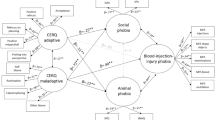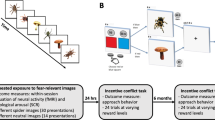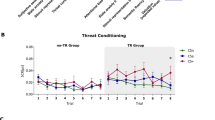Abstract
The present study examined whether the cognitive bias for threat is a stable phenomenon in spider phobics and not in nonphobic controls. The rationale of this study was that the use of emotional bias for individual assessment in clinical practice requires stability of this phenomenon. In order to assess the stability of the emotional bias, the spider Stroop task was administered twice to spider phobics and controls, with a time lag of 3 weeks. In two experiments, spider phobics (nexp. 1 = 20; nexp. 2 = 33) and controls (nexp. 1 = 24; nexp. 2 = 25) were selected on basis of a structured interview. In the second experiment, subjects anticipated exposure to a real-life spider. Emotional bias was inferred from color-naming latencies on spider words versus control words. In line with our prediction, the bias for threat was stable in spider phobic individuals but not in controls. This stability could not be attributed to a general cognitive characteristic because a standard Stroop task did not differentiate between the spider phobics and the controls. The results support the view that cognitive processing of threat in anxiety is stable. It is proposed to use both the emotional bias and its stability as measures of the constraints on the flexibility of the cognitive fear-network.
Similar content being viewed by others
REFERENCES
Bouton, M. E. (1988). Context and ambiguity in the extinction of emotional learning: Implications for exposure therapy. Behaviour Research and Therapy, 26, 137–149.
Chen, E., Lewin, M. R., & Craske, M. (1996). Effects of state anxiety on selective processing of threatening information. Cognition and Emotion, 10, 225–240.
Cohen, J. (1988). Statistical power analysis for the behavioral sciences (pp. 109–143). Hillsdale, NJ: Lawrence Erlbaum Associates.
Dawkins, K., & Furnham, A. (1989). The color naming of emotional words. British Journal of Psychology, 80, 383–389.
Globus, G. G., & Arpaia, J. P. (1993). Psychiatry and the new dynamics. Biological Psychiatry, 35, 352–364.
Kindt, M., & Brosschot, J. F. (1997). Phobia-related cognitive bias for pictorial and Journal of Abnormal Psychology, 106, 644–648.
Kindt, M., Bierman, D., & Brosschot, J. F. (1996). Stroop versus Stroop: comparison of a card format and a single-trial format of the standard color-word Stroop task and the emotional Stroop task. Personality and Individual Differences, 21, 653–661.
Klorman, R., Weerts, T. C., Hastings, J. E., Melamed, G. B. G., & Lang, P. J. (1974). Psychometric description of some specific fear questionnaires. Behavior Therapy, 5, 401–409.
Lavy, E., & van den Hout, M. (1993). Selective attention evidenced by pictorial and linguistic Stroop tasks. Behavior Therapy, 24, 645–657.
Lavy, E., van den Hout, M., & Arntz, A. (1993). Attentional bias and spider phobia: conceptual and clinical issues. Behaviour Research and Therapy, 31, 17–24.
Logan, A. C., & Goetsch, V. L. (1993). Attention to external threat cues in anxiety states. Clinical Psychology Review, 13, 541–559.
MacLeod, C., & Mathews, A. M. (1991). Cognitive-experimental approaches to the emotional disorders. In P. R. Martin (Ed.), Handbook of behavior therapy and psychological science: An integrative approach (pp. 116–150). New York: Pergamon.
Mathews, A., & MacLeod, C. (1994). Cognitive approaches to emotion and emotional disorders. Annual Review of Psychology, 45, 25–50.
Mathews, A., Mogg, K., Kentish, J., & Eysenck, M. (1995). Effects of psychological treatment on cognitive bias in generalized anxiety disorder. Behaviour Research and Therapy, 33, 293–303.
Mattia, J. I., Heimberg, R. G., & Hope, D. A. (1993). The revised Stroop color-naming task in social phobics. Behaviour Research and Therapy, 31, 305–313.
Mogg, K., Bradley, B. P., Millar, N., & White, J. (1995). A follow-up study of cognitive bias in generalized anxiety disorder. Behaviour Research and Therapy, 33, 927–935.
Spielberger, C. D., Gorsuch, R. L., & Lusthene, R. E. (1970). Manual for the State-Trait Anxiety Inventory, Palo Alto, CA: Consulting Psychologists Press.
Stroop, J. R. (1935). Studies of interference in serial verbal reactions. Journal of Experimental Psychology, 225, 643–662.
Teasdale, J. D., & Barnard, P. J. (1993). Affect, cognition, and change: Re-modelling depressive thought. Hillsdale, NJ: Erlbaum.
Watts, F. N., McKenna, F. P., Sharrock, R., & Trezise, L. (1986). Color naming of phobia-related words. British Journal of Psychology, 77, 97–108.
Author information
Authors and Affiliations
Rights and permissions
About this article
Cite this article
Kindt, M., Brosschot, J.F. Stability of Cognitive Bias for Threat Cues in Phobia. Journal of Psychopathology and Behavioral Assessment 20, 351–367 (1998). https://doi.org/10.1023/A:1021919707210
Issue Date:
DOI: https://doi.org/10.1023/A:1021919707210




